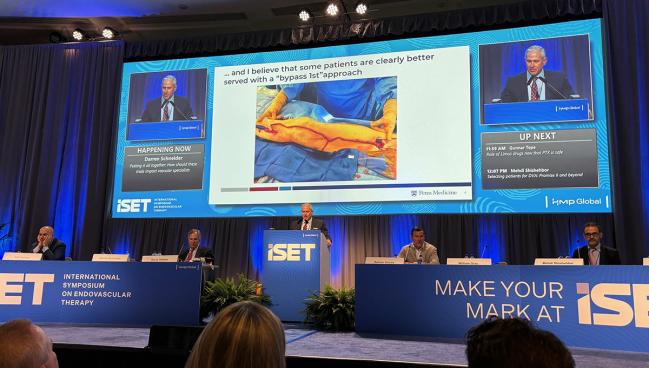How to Reconcile BEST-CLI and BASIL-2? A ‘Patient-First’ Strategy
Experts at ISET hashed out the details, shared new data on bypass vs endo, and tried to make sense of it all as CLTI care evolves.

MIAMI BEACH, FL—Contradictory results from BEST-CLI and BASIL-2 have left clinicians with a puzzle: how to choose between bypass surgery and endovascular therapy as an initial strategy for treating chronic limb-threatening ischemia (CLTI)? Experts here at ISET 2024, including investigators from both trials as well as outside voices, called for a “patient-first” approach to care in this challenging disease.
Just last year, at ISET 2023, vascular specialists were weighing how to integrate the recently published BEST-CLI results into their practice—the trial ranked vascular surgery over endovascular therapy as the best first option, when possible, for revascularization in patients with CLTI and infrainguinal disease. BASIL-2, published in the months that followed, added further complexity by supporting an “endo-first” approach in patients with CLTI and infrapopliteal disease.
Alik Farber, MD (Boston Medical Center, MA), co-principal investigator of BEST-CLI, and Andrew W. Bradbury, MD (University of Birmingham, England), principal investigator BASIL-2, started out yesterday’s discussion by exploring where their trials overlap and diverge.
The question of how best to address CLTI remains crucial, said Barry Katzen, MD (Miami Cardiac & Vascular Institute, FL), the session’s moderator and an ISET course director. “We know that the numbers of patients suffering from this and the incidence of amputation [are] still major problems for all of us involved in treating the disease.”
Darren B. Schneider, MD (University of Pennsylvania, Philadelphia), whose presentation tried to reconcile BEST-CLI and BASIL-2, specified he does both endovascular and surgical revascularization but said that comparing the two trials is “somewhat of an apples and oranges comparison.”
“If you start digging down and looking at the two trials and finding out where they’re different and similar, I think they’re really different trials,” he said. In “BASIL-2, the patients were significantly older, it was a much more homogenous population, a lot of those patients had significant cardiac comorbidities,” as well as prior limb interventions and more distal disease than in the BEST-CLI, he explained. BASIL-2 was an all-tibial trial, whereas BEST-CLI involved various techniques. “And the endpoints, of course, are radically different,” with BEST-CLI emphasizing limb events and BASIL-2 emphasizing mortality.
For clinicians trying to make sense of it all, a key message is that “not all CLTI patients are the same,” said Schneider. “Level 1 evidence supports a ‘patient-first’ approach and that’s what we should all be thinking and considering all of the options.” Specifically, CLTI patients should undergo vein mapping and, if they have a suitable single-segment great saphenous vein (SSGSV) conduit, bypass should be considered as the first strategy, he advised, whereas endovascular therapy should be considered in patients with primarily tibial disease, particularly if they are frail.
“Certainly, there is a complementary role for both strategies and we need to be proficient in both. Multidisciplinary teams are critical to optimal outcomes in this really complex patient population. And I think first and foremost, we’ve got to do something about survival,” which hasn’t substantially improved over two decades, Schneider concluded.
Mehdi H. Shishehbor, DO, PhD (University Hospitals Cleveland, OH), who spent his time at the podium discussing the PROMISE II trial of deep-vein arterialization in “no-option patients” unable to undergo either type of revascularization, told TCTMD that most clinicians in this space have, despite the ongoing conversations, already reached their own verdict about the disparate results from BEST-CLI and BASIL-2.
For CLTI patients suitable for either bypass or endovascular therapy who had an adequate SSGSV—cohort 1— bypass was a significantly more effective revascularization strategy. Alik Farber
His advice for those still trying to parse the data: “Don’t make it too complicated.”
“The most important message is that you’ve got to put the patient at the center, and you’ve got to be realistic about your skill sets. . . . The reality is that these technologies all work for the proper patient, with the right patient selection,” he said in an interview. “I think we can get into the nitty gritty, all the limitations of the trials—there is no perfect trial and they all have a number of limitations. To be honest, none of them are real world.”
Also key for CLTI patients is “continuity of care,” Shishehbor added. “It’s not just about the procedure. . . . They need wound care, they need to be seen, they need their risk factors modified. There’s a lot of death and morbidity in these patients, and we need to address this.”
BEST-CLI
At the outset of his presentation on BEST-CLI, Farber said that he had already heard critiques and misconceptions about the trial at ISET 2024 but due to time constraints wouldn’t attempt to correct them. He implied such comments were financially motivated, given the current $5 billion CLTI global market size, saying: “As you know, nobody is selling saphenous vein [bypass].”
BEST-CLI, funded by the US National Institutes of Health, is far from over, Farber told attendees. There are no fewer than 30 ongoing analyses looking at things like technical failure, quality of life, and various other outcomes. The Novo Nordisk Foundation has provided funding “to further unpack the data set, to answer many of the remaining questions that are out there,” he said, and angiograms are being collected. Additionally, members of the International BEST-CLI Collaborative are “figuring out what questions need to be asked and how to implement evidence in this space.”
Farber highlighted survey results, recently published online ahead of print in the Journal of Vascular Surgery (JVS), showing that BEST-CLI investigators for the most part were not swayed by the trial’s results. There were no significant changes before versus after in what they saw as the preferred treatment based on TASC II lesion severity, conduit availability, or anatomy. “What this suggests is that BEST-CLI is as relevant today as it was 15 years ago when it was conceived,” he stressed.
Soon to come is another paper set to be released in JVS, this one focusing on the impact of treatment choice on reintervention. On multivariable analysis, major reintervention was less likely with open surgery (HR 0.39 vs endovascular therapy; 95% CI 0.3-0.5) and in patients with infrapopliteal disease only (HR 0.33 vs infrapopliteal plus femoropopliteal; 95% CI 0.16-0.69). Among endovascularly treated patients, drug-coated devices seemed protective compared with plain balloons (HR 3.61; 95% CI 1.66-7.87), Farber reported. Thus, the “initial choice of strategy has downstream impact on retreatment burden in CLTI. . . . At-risk limbs in some CLTI patients may not always be rescuable by secondary interventions.”
Additional data show that surgical bypass with an SSGSV, compared with endovascular treatment, is better at preventing major amputations, he said. The advantage emerges in patients who initially have a minor amputation and then require major amputation the second time around.
None of these new analyses change BEST-CLI’s main message, however. “For CLTI patients suitable for either bypass or endovascular therapy who had an adequate SSGSV—cohort 1— bypass was a significantly more effective revascularization strategy,” Farber concluded.
BASIL-2
Bradbury, sharing the latest news on BASIL-2, pointed out that the trial was entirely funded by the United Kingdom’s National Institute for Health and Care Research, not by industry.
He reminded the ISET audience that the advantage for endovascular therapy seen in BASIL-2 was driven by the higher likelihood of death with surgery (adjusted HR 1.37; 95% CI 1.00-1.87). But in a new analysis divided by cause of death, the cumulative incidence of cardiac mortality is “clearly higher with bypass. Interestingly, there was no relationship between cardiac mortality and previous MI, CABG, or PCI reported at baseline at the time of randomization,” Bradbury highlighted. For noncardiac death, rates were similar with the two revascularization types.
Endovascular therapy also appears to be more cost-effective than bypass, thanks to being cheaper while also providing better amputation-free survival, he added. It also “somewhat more effective” at delivering more quality-adjusted life-years.
Data published online in the European Journal of Vascular & Endovascular Surgery, however, show that the CLTI patients with infrapopliteal disease who were randomized in BASIL-2 account for just a small subset of the overall CLTI population. This, the paper’s authors say, should be considered when interpreting the trial’s results.
The takeaway remains that BASIL-2 supports a “best endovascular treatment”-first strategy, at least in patients who could reasonably benefit from either option, said Bradbury. Compared with vein bypass, endovascular therapy is “less invasive, less morbid, and generally preferred by patients and their families,” he concluded, reiterating its beneficial impact on amputation, cardiac death, and cost.
Bradbury said BASIL-3, a three-arm trial of endovascular interventions, is slated for presentation at the Charing Cross Symposium in London this April.
Caitlin E. Cox is News Editor of TCTMD and Associate Director, Editorial Content at the Cardiovascular Research Foundation. She produces the…
Read Full BioSources
Farber A. BEST-CLI: as the dust settles, further learnings and conclusions. Presented at: ISET 2024. January 23, 2024. Miami Beach, FL.
Bradbury AW. BASIL-2: Results and further learnings since publications. Presented at: ISET 2024. January 23, 2024. Miami Beach, FL.
Schneider DB. BEST-CLI & BASIL-2: putting it all together: How should these trials impact vascular specialists? Presented at: ISET 2024. January 23, 2024. Miami Beach, FL.
Shishehbor MH. Selecting patients for DVA: PROMISE II and beyond. Presented at: ISET 2024. January 23, 2024. Miami Beach, FL.
Disclosures
- Farber reports serving on the advisory boards of Dialysis-X and iThera Medical; being a consultant to BioGenCell, LeMaitre, and Sanifit; and receiving research support from the Novo Nordisk Foundation.
- Bradbury reports no relevant conflicts of interest.
- Schneider reports receiving grant/research support from Cook and Philips as well as honoraria/travel support from Abbott, Boston Scientific, Cook, Medtronic, Penumbra, Silk Road, Philips, and W. L. Gore.





Comments